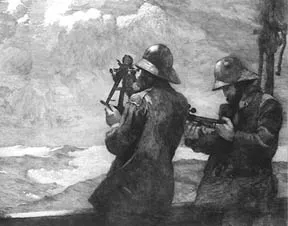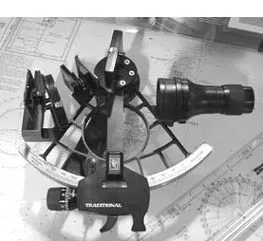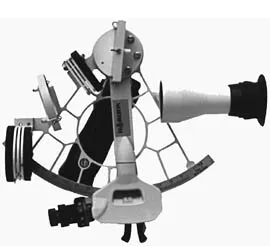It’s been twenty years since we’ve looked at sextants (June 1, 1981), and the sad fact is that with Nick Nicholson in the middle of the Indian Ocean at the moment, there’s no one at PS who feels qualified to do an expert evaluation of the things. It’s shameful but true: we’ve spent two decades focused on increasingly cheap and accurate electronic navigation devices, and we’ve let some of our most important and hardest-won skills atrophy. We are, of course, not much different from most sailors.

So we asked ourselves two questions: Is it worth learning (or re-learning) to use a sextant these days, and if it is, what sextant should we buy? To answer the first question, we did some soul searching. To answer the second we went out and got half a dozen models in our grips, and sought competent advice.
What’s In It For Me?
It used to be so easy: “The prudent navigator will use any means at his disposal… The prudent navigator will not rely on any single aid…”
It’s tempting to think those solemn warnings only applied in the days before we could carry a GPS receiver in every pocket, but even the least paranoid among us knows that’s not true: the GPS system itself can be intentionally switched off or degraded very quickly. It can be physically damaged; it can possibly be sabotaged by hackers. None of those things is likely to happen. More likely are on-the-water problems: GPS receivers can be fried by lightning, dropped overboard, crushed and damaged. Batteries do run out or get soaked.
Well, as any offshore sailor knows, you just carry a back-up handheld. Or two, or three. Plus batteries and waterproof bags.
With all that, the chances of being far offshore without the ability to find a way home have diminished to a point where the demand for sextants has decreased markedly over the past 10 years. Only 68 percent of cruisers responding to a recent Seven Seas Cruising Club poll now carry one aboard. But, as Bill Yrle of Baker and Lyman, long-time importers of Cassens and Plath instruments noted: “It’s not what it was, but the demand for sextants has steadied. It’s sailors rather than professional navigators who are interested in sextants now. There’s a reasonable and steady demand. It’s not so much that people need to have them — it’s that they want to use them to navigate.”
From the days of Captain Cook, the sextant has been the mark of the venturesome sailor. Much of today’s interest in sextants stems from that tradition. Like chess, celestial navigation starts with easy openers, and like chess it can challenge you for a lifetime. One sailor said, “it’s like being able to splice; it’s part of the territory.”
There’s more to it than that. Reading the sky not only tells us where we are — it connects us with all those who for centuries made their way over the world’s waters with nothing more than simple instruments and tables, and the wisdom handed down to them on how to use them. Those skills, in turn, connect us in a practical way to the relationship of the earth to the sun, moon, and stars — a relationship that fewer and fewer sailors understand, to their detriment. The challenge of reading data on a GPS receiver pales next to the challenge of navigating by sextant, and for many people the resultant levels of satisfaction are proportional.
From our point of view, prudence alone might no longer send us scurrying out to the nearest sextant store, but a bit of prudence combined with a simple urge to know how, to reacquaint, is enough for us.
Selecting a Sextant
The clearer you are about your intended uses for the sextant, the better your chance of finding a place along the price range where your standards of value can be met. You can spend anywhere from $19.95 up to $3,000 for a serviceable sextant. The cheapest are made of cardboard (a German-made kit available through Celestaire) and plastic. While the cardboard kit is something of a novelty item with limited navigational potential (and no waterproofing) the plastic sextants made by Davis are “truly viable instruments for celestial navigation.” Almost half of the sextants logged in the Seven Seas Cruising Club survey were made by Davis.
Still, most salts say plastic sextants aren’t reliable enough for “real” navigation and that they should be limited to practice and/or lifeboat duty. The other side of the story is that the Davis sextants, when used and adjusted by those who understand them, can yield results that are very close to those received from metal sextants: While most metal sextants can be shown to yield accuracy within a nautical mile (generally conceded to be about as close as a mortal can come to perfection on a regular basis) the limitations built into plastic sextants give them a margin of error of five miles at best.
We found it surprising, but when you enter the realm of precision metal sextants, instrument accuracy is really the least of your worries. Virtually all new sextants have negligible instrument or uncorrectable error. They also come with instructions for removing index (correctable) error. At that point you can bank on your new sextant as being virtually error free. Data reduction, refraction, and the oblateness of the earth are all more likely to be sources of inaccuracy than the sextant itself.
Perhaps the biggest development in sextants over the past 20 years has been an across-the-board improvement of the optics involved. Mirrors have gotten bigger, coatings have been hardened, scopes made more versatile. Whether the sextant you buy comes from Germany, Japan, or China, you’re likely to find that the optics are first-class.
Part of the new optical improvements wave is the full-horizon mirror. An alternative to the traditional half-glass used to view the horizon, the full-horizon glass (also called “beam converger”) allows you to see both the celestial body and the full horizon. While there are still navigators who prefer the “half-full” glass of tradition, the new viewer makes it easier, especially for beginning navigators, to bring a body to the horizon (though the full-horizoned glass is reported to admit minimally less light and therefore occasion some difficulty in star-finding).
Fitting a sextant with a telescope is also part of the process. Most sextants come with 4 x 40 or 3.5 x 40 viewfinders. These standard scopes provide a modest amount of magnification that helps acquire and retain celestial targets. Larger (6 x 30) scopes with greater magnification are often used for sun sights; a larger image makes it easier to determine when the lower limb of the sun is tangent to the horizon. A clear sight tube suits the sextant for rough weather, horizontal angles, and star finding. Many navigators change scopes to suit conditions. It’s particularly convenient if your sextant case provides room to stow more than one scope for this purpose.

Sextant cases vary a great deal, but whether the box is plywood, plastic, aluminum, or mahogany makes much less difference than how well the instrument is immobilized in the box. Celestaire Navigation Equipment, a good source for instruments and sextant information, sells an all-weather case that is designed to replace hard cases for onboard use. It’s made of injection-molded ABS plastic, has a silicone o-ring seal (guaranteed to a depth of 33 feet) and can withstand a 2,000 pound compression load. It costs $79 and can be fitted at a slight extra cost with interior foam shaped to fit your particular sextant.
Most navigators like a sextant with some “heft.” Mass helps to steady the instrument. If, however, extending the sextant strains your arms and you’re rushing your sights to be free of its weight, then you’ve got too much heft. Modern sextants range from 2 to just over 4 pounds. Finding one that’s got substance enough to be steady but is light enough not to be taxing is a definite quest.
Comfort in the grip of the handle is also important. Beware an overlycocked wrist and/or a sextant whose weight is not virtually centered around the handle.
Some top-of-the-line sextants are made with brass armatures, but it’s more common today to see framesmade of aluminum. This raises the topic of maintenance and the spectre of dissimilar metals. Even though you will obviously do your best to keep your sextant dry, smallboat use makes it likely that sooner or later it will get wet. Rinsing with fresh water and patting the sextant dry with a clean cloth is generally all that’s required, but pay particular attention to those spots (like the stainless steel screws holding the mirror frame to the aluminum arm) where dissimilar metals are in contact.
Many factors have contributed to reducing the selection of sextants available today to a fraction of what it was 20 or even five years ago. Duties from Germany have priced previously affordable units like the Freiberger Drum sextants effectively out of the American market. C. Plath has announced an end to its sextant production. Currency fluctuations have hurt several Japanese sextants. Still, our survey found a solid half dozen that offer, we feel, representative choice in construction, precision, and price, as well as significant variation in size and features.
Davis Mk 15
A black plastic sextant, the Mk 15 has a traditional split mirror. It is not illuminated. Mirror adjustment needs attention and index correction varies with temperature variations. It weighs 15 oz. and comes with four index and three horizon shades. Says David Burch of Starpath School of Navigation, “Plastic sextants are often disparaged for inherent lack of accuracy, but, while it ‘s true that they’re not as accurate as metal sextants… plastic sextants can, with care, still be used quite successfully for navigation at sea.” Burch outlines the procedures involved in reducing sextant error to “about 5 miles” in a treatise on plastic sextants that is available on his website: www.starpath,com.
At $119 the Mk 15 is an excellent first sextant. As an adjunct for lifeboat service it can be stowed in a ditch kit with the Celesticomp calculator ($279). The battery-powered handheld contains all of the tables necessary to do sight reductions.
Davis Mk 25
The Mk 25 is made from gray (temperature-resistant) plastic. It has an illuminated arc and the horizon mirror is full-view. Like the Mk 15 it comes with instruction book, neck lanyard, sight tube, and 3x scope. Its traditional shape, good-sized mirrors, seven securely mounted shades, micrometer, vernier, and good-sized hand grip all mark it as a “real” sextant. Still, as with all plastic sextants, the coefficient of expansion of the material means that temperature variations will produce significant change, and therefore the need for significant correction, due to variations in temperature. You don’t want to leave the sextant in the sun for long or expect it to go gently from a warm box to a cold environment. This basic instability makes attention to index error a full-time concern, but many navigators say the problem is over-rated.

The “push/pull” focus on the 3x telescope is easy enough, but focusing on infinity required pushing the tube to its limit (leaving little or no margin to adjust to various eye strengths.) Between the micrometer drum and the vernier is a small gap that makes reading minutes and fifths of minutes harder than we’d like.
One key to getting good results with a plastic sextant is mirror adjustment. The grades of adjustment aren’t as fine as you’ll find on a metal sextant, nor is the permanence of setting. Once the navigator accepts these realities and learns to tend to his mirrors on a regular basis (as regular as every sight, we would suggest) he can expect results that put him in close competition with a metal sextant. And he can congratulate himself on getting them at a price under $200.
Astra III B
One reason why the selection of traditional metal sextants has shrunk over the years is the extraordinary success of this Chinese-made unit. Fabricated by Changzou Celestaire Instrument Co., the Astra III B offers high quality, accuracy, and top of the line precision at a remarkably low price. In the past 15 years over 13,000 have been sold in the U.S. alone. The Astra’s frame is aluminum. This has a lot to do with its tidy overall weight of just 2 lbs. 10 oz. There are more lustrous finishes on German and Japanese competitors, but the Astra has much more than price to recommend it. Optics are excellent. Each mirror and shade glass, for instance, is tested for perfect flatness by the Fresnel pattern diffraction method. The sextant also offers interchangeable horizon mirrors allowing the navigator to make the shift quickly to suit his preference. While the Standard model has a round index mirror with the silvering applied behind the glass, the deluxe version has a rectangular index mirror with front-face silvering. Versatility in the case of horizon mirrors and leading edge design of the index mirror help explain the Astra’s appeal.
Judged against the silky feel of the best German sextants, the Astra is a bit “sticky.” We had some small worries about those places in the Astra where stainless steel set screws and mirror clips are asked to co-exist with aluminum. Still, the promise of precision is genuine and the list price of around $445 (for the deluxe) is very attractive.
Tamaya Jupiter
The Jupiter combines an aluminum alloy frame with a brass arc. The sextant still tips the scales at a robust 4 pounds, but it achieves an excellent comfort level due to its balance and the ease of working the brass arc. And it’s attractive. The frame is painted in dull black while the other parts are semi-gloss black. Its mirrors are the largest available. It has seven large shades. The mirrors are held firmly in place by the same retainer clips used in the finest German instruments. The telescope is first class, and there is an optional 7×35 monocular scope. The tangent screw assembly is exposed for ease of maintenance and cleaning. The arm is electrically lit.
Tamayas have long been recognized for high quality at a competitive price. Unfortunately, while quality remains first-rate, currency fluctuations have made the Jupiter less of a bargain. It sells for $1,395.
Cassens & Plath Standard
Despite the plethora of sextant makers who use it, the name “Plath” still carries great weight in the sextant world. Cassens & Plath (partners with Weems & Plath of Annapolis, MD) is in Bremerhaven, Germany. “C. Plath,” the original “Plath,” is in Hamburg but they have recently discontinued sextant manufacture. The Cassens & Plath Standard emerges, then, as “the most popular solid brass professional sextant in the world.”
The Standard has a guaranteed accuracy of better than 9 seconds of arc. The frame and arc are constructed of special brass alloy, and the entire instrument has been treated and enameled to prevent corrosion. The very traditional webbed frame with its distinctive large circle in the middle has a gleaming brass arc with black gradations. The mirrors are enormous . Both fixed and variable density polarized sunshades are provided for both the index and horizon mirrors. Lighting of the micrometer drum and arc is powered by 2 AA penlight batteries contained in the handle. The handle is angled to take the weight of the instrument equally on either side, which makes grip and heft very comfortable. The fit and finish of all the parts is smooth, tight, and solid. A distinctive feature is a drum index corrector. This is a separate smaller knob that extends forward from the micrometer drum and which can be turned to quickly reset the index error to 0.
The Standard is offered with either a full-horizon viewer or a split mirror for viewing. A 4 x 40 scope is standard. We prefer square-headed set screws for adjustments because they’re more robust than those that take an Allen wrench, but there is otherwise little to complain about. The standard-setting Cassens & Plath Standard sells for $1,470.
C. Plath Navistars
While the original C. Plath sextant makers have stopped manufacture, we include their sextants—the Navistar Classic, which uses a bronze frame that reduces temperature-induced error to almost nothing, and the less expensive brass-framed Navistar Traditional — because they’re regarded as the best in the world, and are still widely (if temporarily) available. The ruthless simplicity of their design, the seamless precision of their execution, and the organic feel of their balance may well be “intangibles,” but they seem as much a part of these sextants as mirrors or clamps.
Dan Dickinson at Weems & Plath in Annapolis, long importers of C. Plath sextants and purveyors of sextants under their own name, says that his company has about 50 of the last issue of Navistar Traditionals for sale at $2,599 apiece. “When they’re gone, that’s it,” Dickinson says.
Conclusions
If we were going to use a sextant as our sole or primary means of navigating today, there would be no point in sparing expense — we’d go for the most accurate instrument we could buy, presumably the C.Plath Classic. The real scenario, though, is that we want to start from scratch and learn the art. To do that we’d start with the Davis MK25 — the whole-horizon mirror and illumination are worth the few dollars more than we’d spend on the MK15 as a starter model. If we liked the art enough to practice and refine it, we’d step up to Celestaire’s Astra IIIB, a well-known, well-liked, and nicely priced mid-range unit.
Contacts- Cassens & Plath, PO Box 290 126, Am Lunediech, 131 Kompasshauss, D-27572, Bremerhaven, Germany Tel: +49 (0) 471 71011. Celestaire, 416 S. Pershing, Wichita, KS 67218; 800/727-9785. Davis Instruments, 3465 Diablo Ave., Hayward, CA 94545; (510) 732-9229. Tamaya Technics, Inc., Tokyo, Japan (through U.S. importers). Weems & Plath, 214 Eastern Avenue, Annapolis, MD 21403; 410/263-6700.







































Don’t send me billing notices when I’m paid up for another year.